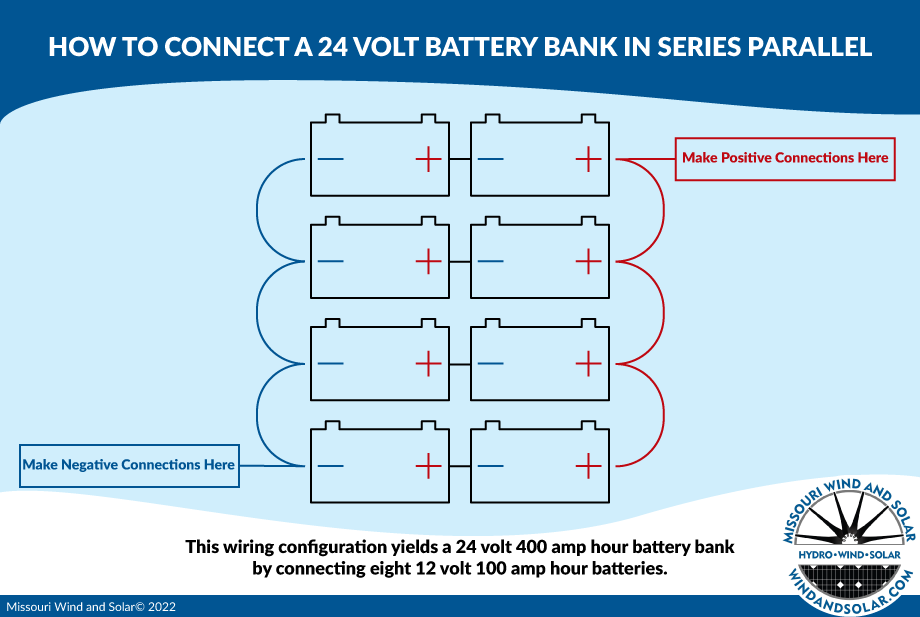Battery Bank Configuration | The Wind & Solar Handbook
Your battery bank is, in many ways, the beating heart of your wind and solar system. Your panels and turbines work to keep your batteries charged so they can keep your home powered. And your battery bank configuration is crucial to your power needs.
Batteries can be quite an investment, so choosing the right type and configuration for your bank should not be an afterthought.
The good news is that, when you learn the proper wiring techniques, you have more flexibility than you might initially assume when it comes to building your battery bank.
Learning a few basic facts about your system’s needs and capacity along with wiring techniques allows you to take control of your system, and build one that truly fits your needs, plans, and budget.
A number of our customers come to us already familiar with the basic concepts of battery wiring. The majority, though, need guidance from our expert staff in order to achieve their independence from the power grid.
If you find the prospect of devising your battery bank configuration a little daunting, we’re here for you. First, we’ll go over some basic battery terms and concepts. Then we’ll dive into the difference between parallel and series wiring.
Once you’re equipped with these battery bank building blocks, you have more flexibility in setting up your system. More flexibility, by extension, means you can dictate more about your system’s cost and performance.
Beginner Battery Basics
Batteries can be a simple tool to learn but can take years to know in all their variations and facets. Fortunately, you don’t need to become a battery expert to make your power system shine. Below are a few terms and concepts that you really need to understand in order to get started.
A battery converts stored chemical energy into electrical energy through a series of reactions between two different metals exposed to an acid. This reaction produces voltage through the transfer of ions between the metals.
Voltage is best explained as a measurement of the potential energy output of the battery. The wider the gap in affinity—the likelihood of attracting an electron—between the two metals involved, the greater the battery’s voltage.
Just because a battery has higher voltage doesn’t mean it’s constantly putting out that level of power.
Current is the rate at which power flows through a circuit. Current is measured in amperes, or amps.
Think of voltage as a reservoir and current as a pipeline: without the pipeline, the water in the reservoir can’t make it to your faucet. Without the reservoir, the pipeline can’t deliver anything. Without the current, the voltage cannot flow power through the wires.
In addition to voltage, current is determined by resistance, which is like the friction in the circuit. It keeps the current from transmitting 100% of the battery’s voltage. This may sound like a bad thing, but it’s crucial to divert excess power from your system.
Your battery has a positive post and a negative post which you’ll use to connect to your system and form either parallel or series connections with the other batteries in your bank.
When connecting to your charge controller, you’ll connect your positive to positive and negative to negative, which is simple enough. But when it comes to connecting to other batteries, things can be more complicated.
Parallel Wiring Batteries to Increase Amperage
If we return to the above analogy where your current is the pipeline bringing water to your house, you may find you need to increase the flow to meet your demand. Parallel wiring schemes help you do just that.
You’re not draining your reservoir of power consistently, but not enough power is flowing through to your devices. If your batteries are still charged but you’re experiencing difficulties, you may need to increase your amperage.
If you look up your battery, you’ll see a measurement called Amp hours. Amp hours tell you how many amps that battery can provide over time before being completely discharged. You may not always operate at this maximum number and rapid discharge and heating can change the rating.
How do you adapt? Say you have two 12 Volt, 100 Amp hour batteries, and you need to create a 200 Amp hour battery bank without increasing the voltage. Here’s how you do it.
Connect the positive posts on battery A to battery B and the positive output to the positive post on battery A. Next, connect the negative posts on batteries A and B, and the negative output to the negative post on battery B.

This is a two-string parallel battery bank. You can add another battery to make a three-string parallel battery bank. Since they are each 100 Amp hour batteries, three in parallel total 300 Amp hours.
It’s important to remember that the output connections should always be on the first and last batteries in the string (with certain exceptions for some lithium batteries as outlined in their manuals).
It is not recommended that you exceed four strings of parallel batteries for most batteries, since parallel wiring schemes don’t evenly distribute charging loads to the batteries. To get that equal charge distribution, you’ll need to incorporate series wiring.
Series Wiring Batteries to Increase Voltage
If your batteries are draining and leaving you stranded, series wiring can increase your reservoir of power and decrease the amount of energy you need to pull from the grid in order to compensate.
Let’s say you have those two 12 Volt batteries and a 24 Volt charge controller. Parallel wiring won’t help you hit your system’s voltage capabilities since it only boosts amperage.
Instead, connect the positive post on battery A to the negative post on battery B. Then, connect the negative output to the negative post on battery A. Connect the positive output to the positive post on battery B.

Voila, a 24 Volt battery bank.
These concepts don’t just work with batteries, either. Say you have two 12 Volt solar panels but need to charge a 24 Volt battery bank. Follow the same principles to create a 24 Volt panel bank.
Remember, the output always connects to the batteries or other devices positive to positive, negative to negative. In series wiring, the connections between the batteries or devices go from positive to negative.
With series wiring, you have flexibility when it comes to battery shopping. Have a 48 Volt charge controller? Wire four 12 Volts in series to match its capacity. Or eight six Volt batteries. Maybe 24 two Volt cells if that’s right for you.
On their own, parallel and series wiring techniques unlock different battery configurations previously unavailable to you. Together, they’re even more effective.
Series Parallel Wiring for Battery Banks
How do you combine parallel and series wiring for your battery bank? It’s simpler than one might think thanks to series parallel wiring.
Let’s suppose you have eight 12 Volt, 100 Amp hour batteries and you need a 24 Volt, 400 Amp hour battery bank.
First, pair off your batteries and wire each pair in series, turning eight 12 Volt batteries into, essentially, four 24 Volt batteries. Each pair should now have one open positive and negative post.
Just like what was described in the section on parallel wiring, connect each of the negative posts to each other and each of the positive posts to each other.
Then, connect the positive post on the first battery to the positive output, and the negative post on the last battery to the negative output. Since you’re only wiring four 24 Volt batteries in parallel, your Amp hours will go from 100 to 400.
Batteries aren’t cheap because they shouldn’t be cheaply made. Even the most affordable style of battery can cost nearly $200. Having the flexibility to build your battery bank without breaking the bank is key for many of our customers.
Your battery bank configuration can unlock the potential of your system, free you from the power grid, and help you achieve self-reliant energy.
FAQ
Why are lithium batteries more expensive?
For one thing, it’s a new technology that’s in high demand. We’ve seen the price drop over the years (and we only started carrying lithium batteries when the price reached a point that was justifiable for our customers).
As time goes on, the technology refines, and more manufacturers enter the market, the price should continue to drop.
However, it’s important to note that while the up-front cost is high, lithium batteries last much longer than other styles. Your cost per chargecycle is therefore significantly lower.
Which is safer, series wiring or parallel wiring?
As long as you follow the proper procedures and common-sense safety practices, both parallel and series wiring should be equally safe. Whatever your setup, make sure your batteries’ voltage matches your system’s requirements and that all batteries in your bank are the same voltage.
How should I store my battery bank?
However you configure your battery bank, we recommend you space the batteries far enough apart to permit air to flow around them, allowing them to cool. Additionally, lead acid batteries need to be able to vent to the outside, so if you enclose them, make sure each side has ample ventilation.
Can you fry your batteries by attempting to do parallel or series wiring?
As long as you follow the guidelines stated above—avoid linking more than four strings in parallel and overcharging your bank—you're at no increased risk of damaging your batteries.
You can damage your batteries with any wiring scheme if you treat them improperly.
How do I know when it’s time to get new batteries?
There is no set timescale for when to replace your batteries, since your system usage dictates their lifespan. Look for a decline in your battery’s performance (lights are an especially handy giveaway for this) and diminished charging and discharging.
For users with average demand, this could take 10 or 15 years. If you notice this happening much earlier, it could be a sign of a problem elsewhere in your system.
Recent Posts
-
Wind Turbine for Cabin | Alternative Energy for Remote Homes
Remote homes, whether cabins, hunting lodges, or vacation homes are excellent places to implement al …Dec 8th 2022 -
Lithium Ion Battery Pros & Cons | A User’s Guide
Lithium batteries are often seen as the vanguard of the alternative energy revolution. They offer …Nov 7th 2022 -
Battery Bank Configuration | The Wind & Solar Handbook
Your battery bank is, in many ways, the beating heart of your wind and solar system. Your panels and …Oct 19th 2022




